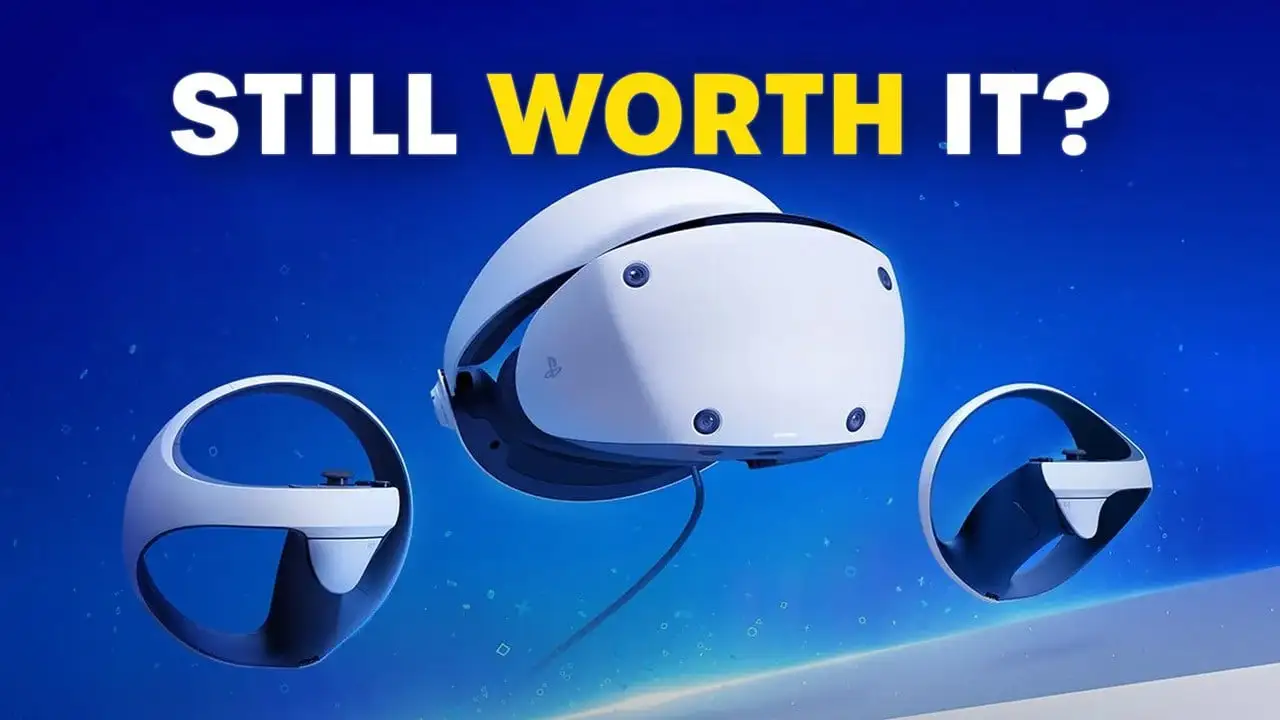Estimated Reading Time: 28-32 minutes (5,541 words)
Introduction
Virtual Reality (VR) gaming has long stood at the edge of mainstream adoption — an exciting, futuristic technology that promised to redefine how we play, explore, and connect. For years, it has been the “next big thing” in gaming, but often just out of reach due to high costs, clunky hardware, limited titles, and accessibility issues. However, 2025 feels different. With devices like Meta Quest 3, PlayStation VR2, Apple Vision Pro, and Pico 4 making waves, and VR arcades emerging across Indian metros, the market is showing signs of real maturity. The once-niche segment is turning into a legitimate ecosystem, not just for hardcore gamers but also for casual players and creators.
Yet, the big question remains — is VR gaming finally worth it in 2025? For gamers in India and beyond, this isn’t just about tech specs or hype; it’s about value and experience. Is the performance now good enough to justify the cost? Are the titles compelling enough to replace traditional gaming setups? Is motion sickness still an issue, and do Indian internet speeds support multiplayer VR experiences? These are real concerns that need clear, practical answers before making a purchase.
In this blog, we’ll break it all down — backed by global market data, industry case studies, and a strong India-first perspective. You’ll discover where VR gaming truly stands today, what’s driving its growth, and whether it makes sense for your budget and lifestyle. Plus, we’ll share actionable insights on how you can make the most of this shift — from getting the best value out of your headset to tapping into the booming VR creator and affiliate economy. Whether you’re a gamer, a tech blogger, or a digital entrepreneur, this guide will help you decide if 2025 is finally the year VR gaming delivers on its promise.

Market Snapshot – Global & India
🌍 Global Overview: VR Gaming Comes of Age
The global VR gaming industry has entered a strong acceleration phase in 2025. According to The Business Research Company, the global VR-in-gaming market is expected to grow from US $19.24 billion in 2024 to US $24.33 billion in 2025, reflecting an impressive CAGR of around 26.5%. This surge is driven by better hardware performance, more affordable standalone headsets, and the increasing adoption of cloud-based VR platforms that reduce dependency on expensive gaming PCs.
Other analysts — including Technavio and Cognitive Market Research — predict high double-digit growth through the late 2020s, suggesting VR gaming could become a core pillar of the global gaming ecosystem by 2030. While the broader gaming market (worth over US $200 billion) continues to be dominated by mobile gaming, VR represents a smaller but faster-growing segment. Reports from Udonis Mobile Marketing Agency note that VR’s growth rate outpaces both console and PC segments, largely because of the rising demand for immersive entertainment and new metaverse-related applications.
Driving this expansion are significant improvements in visual fidelity, wireless freedom, and accessibility. Headsets like Meta Quest 3, PlayStation VR2, and Apple Vision Pro are expanding beyond gaming into productivity, fitness, and social VR — effectively turning headsets into lifestyle devices. With tech giants like Sony, Meta, Apple, and ByteDance investing heavily in ecosystem development, the VR gaming market is poised to transition from a niche enthusiast market to a mainstream entertainment vertical.
🇮🇳 India: From Curiosity to Emerging Market Leader
India’s VR gaming scene, while still in its early growth stage, is showing remarkable momentum. As per IMARC Group, the Indian VR gaming market was valued at US $4.20 billion in 2024 and is projected to skyrocket to US $30.20 billion by 2033, achieving a CAGR of approximately 21.7% (2025–2033). This makes India one of the fastest-growing VR gaming markets globally, thanks to its young gamer population, improving internet infrastructure, and rising disposable incomes.
On the hardware front, India’s VR headset market is catching up too — estimated at US $1.30 billion in 2024, it’s projected to reach US $5.30 billion by 2033 (CAGR ~15.4%). Beyond gaming, India’s extended reality (XR) ecosystem — including AR, MR, and industrial VR — is expanding at a 30%+ CAGR, driven by educational, healthcare, and corporate use cases. The adoption of 5G, local gaming startups, and VR arcades in Tier-1 and Tier-2 cities like Bengaluru, Pune, and Hyderabad is also creating more entry points for first-time users.
Despite this surge, VR gaming in India faces affordability barriers. High import duties, shipping costs, and currency conversion make devices like Meta Quest 3 (₹60,000+) less accessible to casual gamers. Nevertheless, with homegrown innovations (like AjnaLens and Gamitronics) and rising investments in location-based VR entertainment, India is fast becoming a strategic frontier for global VR brands.
📊 Key Data Snapshot
| Region | 2024 Market Value | Forecast Value | CAGR | Source |
| Global VR Gaming | US $19.24 B | US $24.33 B (2025) | ~26.5% | The Business Research Company |
| India VR Gaming | US $4.20 B | US $30.20 B (2033) | ~21.7% | IMARC Group |
| India VR Headsets | US $1.30 B | US $5.30 B (2033) | ~15.4% | IMARC Group |
🚀 Key Growth Drivers
- Affordable, Standalone Hardware: Headsets no longer need PCs or consoles (e.g., Meta Quest 3, Pico 4).
- Richer Game Libraries: AAA studios and indie developers alike are releasing VR titles with higher replay value (e.g., Half-Life: Alyx, Asgard’s Wrath 2).
- VR Arcades & Events: India’s growing network of VR cafés, malls, and amusement centers introduces VR to new audiences.
- Developer Expansion: Rising participation from Indian VR studios, freelancers, and Unity/Unreal developers.
- Immersive Fitness & Social Platforms: Games like Supernatural and Beat Saber are making VR a tool for fitness and connection.
⚠️ Key Obstacles & Limitations
- High Cost Barrier: Even as prices drop globally, import taxes and lack of local manufacturing make VR headsets expensive in India.
- Limited Content Depth: Compared to traditional gaming, VR’s library is smaller, and many gamers feel there are “not enough must-play titles” (Hacker News).
- Space & Comfort Constraints: Players need physical room to move safely, and motion sickness remains a deterrent for some users.
- Platform Fragmentation: Multiple ecosystems (PC-VR, console VR, standalone, mobile) make choices confusing and fragment developer efforts.
- Ecosystem Risk: Some platforms, like Android XR, are getting less developer focus, raising long-term sustainability concerns (Android Central).
Summary Insight:
Globally, VR gaming is on the cusp of mainstream adoption, with strong growth projected across all major markets. In India, the ecosystem is rapidly evolving — powered by infrastructure growth, local innovation, and a youthful audience base. However, affordability, accessibility, and content diversity will determine how soon VR transitions from “premium novelty” to “daily entertainment.”
Cost–Benefit Analysis: Should You Buy Now?
When it comes to VR gaming in 2025, the question isn’t just “Is it fun?” — it’s “Is it worth the money, space, and learning curve?” The cost-benefit equation depends heavily on your budget, gaming style, and long-term goals. Let’s break down what you’re actually paying for — and what you’re truly getting in return.
💸 Key Cost Components
- Headset Hardware:
- Premium VR headsets (like the Meta Quest 3, PlayStation VR2, or Apple Vision Pro) range between US $400–$800+ (₹35,000–₹70,000+), depending on model and region. These offer high resolution (2K+ per eye), advanced tracking, and standalone performance without needing a PC.
- Budget VR options, such as JioDive VR Headset (₹1,299) or Pico Neo series, provide entry-level experiences using smartphones or lightweight processors. However, they deliver far lower immersion, limited tracking, and less engaging visuals — suitable mainly for first-timers or casual experiences like 360° videos.
- Premium VR headsets (like the Meta Quest 3, PlayStation VR2, or Apple Vision Pro) range between US $400–$800+ (₹35,000–₹70,000+), depending on model and region. These offer high resolution (2K+ per eye), advanced tracking, and standalone performance without needing a PC.
- Accessories & Add-ons:
- Enthusiasts often invest in controllers, base stations (for PC-VR like Valve Index), facial interfaces, or comfort straps, adding another US $50–200 (₹4,000–₹16,000) to the total cost. Some headsets (like Quest 3) include these in-box, but upgrades for ergonomics or extended battery life are common.
- Enthusiasts often invest in controllers, base stations (for PC-VR like Valve Index), facial interfaces, or comfort straps, adding another US $50–200 (₹4,000–₹16,000) to the total cost. Some headsets (like Quest 3) include these in-box, but upgrades for ergonomics or extended battery life are common.
- Game & Library Costs:
- While many VR apps are free, top-rated VR games (Beat Saber, Asgard’s Wrath 2, Half-Life: Alyx, Superhot VR) range between US $20–60 each.
- Some require a high-end gaming PC or console to run, adding potential hardware costs upwards of US $800–1,500 (₹70,000–₹1.3 lakh) if you don’t already own one.
- While many VR apps are free, top-rated VR games (Beat Saber, Asgard’s Wrath 2, Half-Life: Alyx, Superhot VR) range between US $20–60 each.
- Space & Setup:
- VR gaming isn’t plug-and-play — you’ll need 2×2 meters of free movement area for room-scale experiences, along with proper lighting and cable management. Small apartments (common in Indian cities) can make this challenging.
- VR gaming isn’t plug-and-play — you’ll need 2×2 meters of free movement area for room-scale experiences, along with proper lighting and cable management. Small apartments (common in Indian cities) can make this challenging.
- Learning Curve & Maintenance:
- First-time users often spend 1–2 weeks acclimating to VR — learning controls, adjusting comfort settings, and managing potential motion sickness.
- Maintaining device hygiene (lens cleaning, battery management) is also essential for long-term usability.
- First-time users often spend 1–2 weeks acclimating to VR — learning controls, adjusting comfort settings, and managing potential motion sickness.
🌐 Benefits & Use-Cases: Why People Love VR
- Unmatched Immersion:
VR offers a level of presence no flat screen can replicate — you’re inside the game. Every motion, sound, and spatial cue surrounds you. As Reality Remake Gaming notes, “Once you’ve fought zombies or flown in VR, going back to 2D feels flat.” - Unique Gameplay Genres:
- Rhythm Games: Beat Saber, Pistol Whip — full-body rhythm fun.
- Simulations: Microsoft Flight Simulator VR, Gran Turismo 7 VR — hyper-realistic control experiences.
- Social VR: VRChat, Rec Room — hangouts and events in digital spaces.
- Fitness VR: Supernatural, FitXR — workout apps making exercise fun and measurable.
- Rhythm Games: Beat Saber, Pistol Whip — full-body rhythm fun.
- Future-Proofing Your Setup:
Early adopters today benefit from longer relevance, as new software updates often enhance performance without needing new hardware. Buying into VR now ensures you’re part of the growing ecosystem — ready for the next wave of cross-platform content and mixed-reality experiences. - Expanding Beyond Gaming:
- VR is moving into fitness, meditation, training, education, and virtual tourism.
- In India, VR cafés, eSports events, and metaverse expos (like India Gaming Show 2025) are growing rapidly, offering community access and experiential value beyond solo gameplay.
- VR is moving into fitness, meditation, training, education, and virtual tourism.
⚖️ Where the Value Lies — and Where It Doesn’t
✅ Where VR Delivers High Value:
- You’re an enthusiast or content creator who values immersion, novelty, and new experiences.
- You already own a powerful PC/console and want the next frontier in gaming.
- You’re interested in fitness or social VR — where daily utility justifies the cost.
- You want to get in early while the ecosystem matures and prices gradually drop in India.
❌ Where VR Offers Low Value:
- You’re a casual gamer who mainly plays mobile or 2D games.
- You lack sufficient room space or suffer from motion sickness.
- You expect VR to replicate traditional gaming — it’s still different in pacing, design, and comfort.
- You plan to resell quickly — hardware depreciation is steep as new models arrive annually.
🧩 Verdict: Is VR Worth It in 2025?
For many gamers, yes — VR gaming in 2025 is finally worth it, but it depends on your perspective. If you see it as a long-term investment in immersive entertainment and new experiences, it offers excellent value and excitement. Hardware is now powerful enough, games are richer, and ecosystems are stabilizing.
However, for Indian consumers, price sensitivity remains the biggest hurdle. Import taxes, currency fluctuations, and smaller content libraries can dampen ROI. The best approach? Buy smart — choose a versatile headset (like Quest 3 or PS VR2), explore cross-platform titles, and leverage free content while prices fall.
In short:
VR in 2025 is no longer a futuristic gimmick — it’s an evolving platform that rewards early adopters who value immersion, creativity, and experience over pure cost efficiency.
Buying Guide for India (2025)
If you’re planning to buy a VR headset in India in 2025, the options are finally getting more diverse — from premium standalone systems to budget-friendly mobile VR. However, the Indian market still faces challenges such as import duties, limited after-sales support, and smaller local availability. This buying guide breaks down what to look for, the top models available, and smart tips to get the best value for your money.
What to Look for in a VR Headset (India, 2025)
1. Standalone vs. PC/Console-Tethered:
- Standalone headsets (like the Meta Quest 3) are self-contained — no PC or console required — making them easy to use and travel-friendly. They’re ideal for most casual and mid-level gamers.
- PC/Console VR systems (like PlayStation VR2 or HTC Vive Pro 2) offer higher fidelity, better graphics, and larger game libraries — but require powerful PCs or consoles.
- Mobile VR (like JioDive or Irusu headsets) remains the most affordable entry-level option, though it offers limited immersion compared to dedicated systems.
2. Display Resolution & Refresh Rate:
Higher resolution ensures sharper visuals, while higher refresh rates (90 Hz–120 Hz) reduce motion blur and motion sickness. Anything below 90 Hz may feel laggy. Aim for at least 1832×1920 per eye for modern comfort and clarity.
3. Tracking & Controllers:
Inside-out tracking (built-in cameras) is now standard in 2025, eliminating the need for external sensors. Look for headsets with 6DoF (six degrees of freedom) for full-body motion and responsive hand controllers with haptic feedback.
4. Game Library & Platform Compatibility:
Before you buy, check where your favorite VR games live. Meta’s Quest Store, PlayStation Store, and SteamVR each have different exclusives. Cross-platform titles like Beat Saber, Superhot VR, and Half-Life: Alyx offer broader compatibility, but not all systems support every platform.
5. Comfort & Fit:
VR comfort directly affects how long you’ll play. Choose a headset with:
- Adjustable head straps and counterbalanced design.
- Lightweight build (under 600 g ideal).
- Room for glasses (if needed).
- Swappable face pads for hygiene and comfort.
6. Local Support & Import Costs:
Many top-tier VR headsets aren’t officially sold in India. Importing from the U.S. or U.K. can add 28–40% in customs duty. Always check if the seller offers Indian warranty and accessible after-sales service centers.
7. Room-Space & Setup Requirements:
VR systems often require a 2 × 2 m safe play area. Clear obstacles, ensure stable Wi-Fi (for wireless VR), and use boundary-setting tools in software to avoid collisions.
Recommended VR Headsets for India (2025)
1. Meta Quest 3 – Best Overall Standalone VR
- Processor: Qualcomm Snapdragon XR2 Gen 2
- Resolution: 2064×2208 per eye
- Strengths: Excellent standalone experience, large game library, optional PC link
- Ideal for: Mid-range to premium users
2. PlayStation VR2 – Best for Console Gamers
- Requires PlayStation 5
- OLED HDR display (2000×2040 per eye)
- Strengths: Immersive visuals, strong exclusive titles (Horizon Call of the Mountain)
- Ideal for: PS5 owners and narrative-driven gamers
3. JioDive VR Headset – Best Budget Option (Mobile-VR)
- Works with most smartphones (up to 6.7″ screens)
- Strengths: Affordable entry into VR, Made-for-India ecosystem
- Ideal for: Beginners or casual users exploring VR content and OTT experiences
4. Irusu Play VR Ultra Headset – Best Indian Budget Model
- Adjustable lenses, lightweight design
- Strengths: Locally available, low-cost way to experience VR videos/games
- Ideal for: Entry-level and student users
Accessories, Setup & Game Compatibility
- Comfort accessories: Add head straps, face cushions, and cable organizers for long sessions.
- PC-VR users: Ensure your PC has a GPU like RTX 3060 or higher and at least 16 GB RAM.
- Regional pricing: Some titles on SteamVR or Meta’s store have regional price adjustments, but imported accounts may face region locks.
- Indian buyers: Always verify if accessories (like chargers or controllers) are supported under Indian voltage standards.
Pro Tips for Indian Buyers (2025)
✅ Try Before You Buy: Visit VR arcades or demo centers (in cities like Bengaluru, Hyderabad, or Mumbai) to test motion comfort.
💸 Wait for Discounts: Sales on Amazon India or Flipkart during festive seasons (Diwali, Big Billion Days) often include VR devices and accessories.
🧠 Protect Your Investment: Use wrist straps, soft flooring, and wall boundaries to prevent damage.
♻️ Consider Pre-Owned Options: Older models (Quest 2, PS VR1) are available on OLX and Cashify at ~40–50% lower prices — good for entry-level use.
🇮🇳 Stay Updated: Follow Indian VR communities on Reddit or Discord for import tips, repair help, and local events.
Best VR Games & Experiences (2025)
By 2025, VR gaming has evolved far beyond its early “tech demo” phase — it’s now a full-fledged ecosystem with diverse genres, immersive storytelling, and thriving online communities. Whether you’re into high-intensity fitness challenges, cinematic adventures, or social worlds, there’s a VR experience for every kind of player. Here’s a breakdown of the top genres and standout titles worth your time (and rupees) in 2025 — including the growing Indian VR community context.

🎵 1. Rhythm & Fitness Games
These are the titles that truly show what VR can do — get you moving, sweating, and smiling. Perfect for players who want both entertainment and exercise.
- Beat Saber (Meta/PCVR) – The legendary rhythm game continues to dominate with music packs from artists like The Weeknd and BTS. It’s the “must-own” game for any VR user.
- Les Mills BodyCombat VR – Brings gym-style training into your living room, offering real cardio workouts guided by professional trainers.
- Supernatural (Quest) – A subscription-based VR fitness app combining rhythm gameplay with scenic virtual landscapes — popular among global and Indian health influencers.
- FitXR – Ideal for home workouts, dance sessions, and boxing drills — tracks your calories and progress.
💡 India Insight: Fitness-conscious players in metros like Bengaluru, Delhi, and Mumbai are adopting VR workouts as an alternative to gyms, especially in small apartments.
🌍 2. Social VR Worlds & Multiplayer Experiences
In 2025, VR isn’t just about playing games — it’s about meeting people, creating spaces, and living virtually. These platforms are leading the charge:
- VRChat – Still the king of virtual social worlds, offering infinite user-generated avatars and hangout worlds.
- Horizon Worlds (Meta) – Now available in more regions including India, it’s evolving into a metaverse hub for events, comedy shows, and community spaces.
- Rec Room – A family-friendly platform where you can create games, hang out, or play paintball with global friends.
- AltspaceVR (Legacy) – Though discontinued in 2023, its spirit lives on in apps like Vircadia and Spatial, focusing on education, art, and collaboration.
💡 India Insight: Indian VR meetups and gaming communities (like VR Bharat and IndiaVR) are regularly hosting virtual gatherings and tournaments — helping local gamers experience global connection without the high travel cost.
🛫 3. Simulation, Racing & Flight Experiences
For players who dream of being behind the cockpit or the wheel, simulation titles deliver that near-real sensation that only VR can achieve.
- Microsoft Flight Simulator (VR Mode) – The ultimate flying experience, with breathtaking realism; now optimized for modern GPUs and VR headsets.
- Gran Turismo 7 (PlayStation VR2) – Combines elite car physics with VR immersion, making every turn and overtaking maneuver feel tangible.
- No Man’s Sky VR – Explore infinite galaxies and alien worlds in full VR, constantly updated and much smoother than earlier builds.
- VTOL VR – A surprisingly deep flight combat sim that puts realism first — perfect for enthusiasts.
💡 India Insight: While most VR simulation fans in India still rely on PCVR setups, new VR arcades (e.g., Smaaash, Zero Latency India) are making these experiences more accessible to the public.
😱 4. Horror & Escape Room Adventures
VR horror games redefine “scary.” With spatial audio and full-body immersion, even veteran gamers find themselves jumping.
- Resident Evil 4 VR (Remake) – A fan favorite that proves how AAA franchises can shine in VR.
- Phasmophobia VR – Hunt ghosts with your friends in terrifyingly realistic environments — a social horror hit.
- The Walking Dead: Saints & Sinners 2 – Blends survival, melee combat, and storytelling into one intense experience.
- Five Nights at Freddy’s: Help Wanted 2 – Popular among streamers, offering both fun and frights.
💡 India Insight: Horror-based VR zones are growing fast in Indian malls and entertainment centers, particularly in Hyderabad, Pune, and Chennai — perfect for group experiences or date-night thrills.
🎮 5. AAA & Narrative Titles (The Big Leagues)
2025 marks a turning point where big studios are finally embracing VR with full-fledged story-driven games — not just side experiments.
- Asgard’s Wrath 2 (Meta Quest 3) – Epic scale RPG with 60+ hours of content — arguably VR’s “Zelda moment.”
- Half-Life: Alyx (Valve Index/PCVR) – Still the gold standard for realism, interactivity, and storytelling.
- Assassin’s Creed Nexus VR – Ubisoft’s polished take on stealth-action in first-person VR.
- Skyrim VR (Enhanced Edition) – The legendary RPG reimagined for full motion and freedom.
💡 India Insight: Indian players with high-end PCs and gaming rigs are slowly building communities around AAA VR titles, sharing optimization tips, mods, and even local tournaments via Discord and YouTube.
🇮🇳 6. Local Context: The Indian VR Scene
The Indian VR gaming ecosystem is gradually gaining its own identity:
- Indian Studios: Emerging developers like Gamitronics, Tesseract VR, and XR Central are working on localized VR content — from mythological themes (Mahabharata VR Prototype) to educational and training simulations.
- Arcades & Meet-Ups: VR lounges in cities like Mumbai, Bengaluru, and Hyderabad are offering per-hour play sessions, introducing thousands of first-time users to VR each month.
- Multiplayer Communities: Indian players are organizing VRChat meetups, Beat Saber tournaments, and fitness challenges online, often streamed on Twitch and YouTube Gaming.
🕹️ Final Word on VR Games in 2025
If you’re new to VR, start with rhythm and social titles — they’re instantly fun and showcase VR’s strengths. As you grow comfortable, dive into simulation and story-driven games that highlight the medium’s true potential. With global AAA support and India’s rising VR interest, 2025 is shaping up to be VR’s best year yet for gamers and creators alike.
🏆 Top 10 Must-Play VR Games (Ranked for 2025 – India Edition)
VR gaming in 2025 has something for everyone — from rhythm lovers to simulation addicts. Below is a curated, data-driven ranking of the ten best titles that combine high player ratings, replay value, and availability in India.
| Rank | Game Title | Genre | Platforms | Indicative Price (INR/USD) | Best For | Verdict |
| 1 | Asgard’s Wrath 2 | Action RPG / Adventure | Meta Quest 3 / Quest Pro | ₹4,999 (~$59) | Core gamers seeking epic single-player content | VR’s “Zelda moment” — 60+ hours of content, stunning visuals, benchmark for standalone VR |
| 2 | Beat Saber | Rhythm / Fitness | Quest 2 / 3 / PC VR | ₹2,499 (~$30) | Fitness & casual players | Timeless classic; best way to demo VR fun & get fit |
| 3 | Half-Life: Alyx | AAA Shooter / Story Driven | PC VR (SteamVR, Valve Index) | ₹3,999 (~$49) | Hardcore PC gamers | Still the gold standard for immersion, interactivity, and physics |
| 4 | Resident Evil 4 Remake VR Mode | Horror / Shooter | PS VR2 | ₹3,999 (~$49) | Horror & console gamers | AAA polish meets terrifying realism — a must for RE fans |
| 5 | Gran Turismo 7 VR | Racing Simulation | PS VR2 + PS5 | ₹5,499 (~$65) | Racing enthusiasts | Photorealistic driving + full VR immersion = best racing sim today |
| 6 | No Man’s Sky VR | Exploration / Sandbox | PC VR / PS VR2 / Quest 3 (via link) | ₹3,499 (~$42) | Exploration & sci-fi fans | Infinite galaxies & base-building make it endlessly replayable |
| 7 | Supernatural VR | Fitness / Rhythm | Meta Quest 2 / 3 | Subscription ₹1,200/mo (~$15) | Fitness & wellness | Combines workouts + music + travel scenery; perfect for daily VR use |
| 8 | Assassin’s Creed Nexus VR | Stealth / Action | Meta Quest 3 | ₹4,499 (~$54) | Franchise fans | Ubisoft’s polished entry brings true stealth action to VR |
| 9 | Phasmophobia VR | Co-op Horror | PC VR (SteamVR) | ₹999 (~$12) | Streamers & friends | Jump scares + voice chat = perfect social-horror experience |
| 10 | Pistol Whip | Rhythm Shooter | Quest 2 / 3 / PS VR2 | ₹2,099 (~$25) | Fast-action gamers | John Wick meets Beat Saber — stylish, addictive, replayable |
⚡ Quick-Pick Recommendations
- Best for Beginners: Beat Saber or Pistol Whip
- Best for Fitness: Supernatural VR or FitXR
- Best for Storytelling: Asgard’s Wrath 2 or Half-Life: Alyx
- Best for Horror: Resident Evil 4 VR or Phasmophobia VR
- Best for Racing/Simulation: Gran Turismo 7 VR or Microsoft Flight Simulator VR
- Best for Social Play: VRChat or Rec Room
🇮🇳 India-Specific Availability & Tips
- Where to Buy: Official Meta Store (ships to India via Amazon Global), PlayStation India Store, Steam (for PCVR), and select Indian retailers like Irusu and Croma Online.
- Regional Pricing: Steam India and PlayStation Store often have localized pricing (30–50 % cheaper than US).
- Payment & Currency: Use UPI or Paytm Wallet for quick global transactions on platforms that support Indian payment methods.
- Community Tip: Join Discord servers like IndiaVR Community or Meta Quest India Users to find discounts, co-op sessions, and second-hand gear.
🧠 Monetization & Creator Opportunities
- Affiliate Content: Write comparison blogs or YouTube reviews linking to Amazon India/Meta Store.
- Fitness Challenges: Create shorts around Supernatural or Beat Saber scores – huge engagement potential on Reels and YouTube Shorts.
- Streaming Edge: Horror and social VR titles like Phasmophobia and VRChat generate high watch-time due to reactive content.
- VR Events: Collaborate with arcades (e.g., Zero Latency India, Smaaash) for sponsorships and live experiences.
💬 Final Takeaway
Whether you’re in Mumbai, San Francisco, or Berlin, these ten titles showcase the best of what VR gaming can offer in 2025 — from pulse-pounding action to zen-like fitness. For Indian players, availability is no longer a barrier — only your budget and bandwidth decide how deep you go into the metaverse.
Case Study: India Market & Early Adopter Story
- 📈 Market Growth:
The Indian VR gaming market was USD 4.2 billion in 2024 and is projected to reach USD 30.2 billion by 2033, growing at a CAGR of ~21.7% (IMARC Group, openPR 2025).
→ That’s over 7× growth in less than a decade. - 🏙️ Early Adoption Hubs:
Cities like Delhi NCR, Bengaluru, Mumbai, and Hyderabad lead adoption with VR arcades, gaming cafés, and demo zones.
Brands such as Zero Latency, Smaaash, and VRsutz are popular for first-time VR experiences. - 🕹️ Why Standalone Headsets Win in India:
- Lower total cost (no gaming PC or console needed).
- Easier setup and wireless freedom.
- Meta Quest 3 and similar devices offer global app stores and firmware updates.
- Practical 3–5 year lifespan for Indian buyers.
- Lower total cost (no gaming PC or console needed).
- 💬 Community Sentiment:
“Yes, definitely worth it. There was a time when people said VR had not enough games — but that’s a thing of the past.” — Reddit India (2025)
Gamers now view VR as a real upgrade, not a gimmick. - 👤 Early Adopter Example:
Aman Sharma (27, Bengaluru) bought a Meta Quest 3 during Diwali 2024.
→ Uses Beat Saber and Supernatural VR daily, says: “It feels alive.”
→ Monetized experience via YouTube Shorts and affiliate links to VR accessories.
💡 Takeaway:
India’s VR market is transitioning from curiosity to commitment — driven by affordability, content growth, and creator enthusiasm.
For 2025, VR isn’t just a trend — it’s the start of a mainstream gaming movement.
FAQs Section
1. What is VR gaming and how is it different from regular gaming?
VR (Virtual Reality) gaming places you inside the game world instead of watching it on a flat screen. You wear a head-mounted display (HMD) — such as the Meta Quest 3 or PS VR2 — which tracks your head movement, and often use motion controllers or hand tracking to interact naturally. This creates a 360° sense of presence and spatial depth.
Unlike traditional gaming where you control a character via a controller or keyboard, in VR you are the character — dodging, swinging, shooting, and exploring physically. Many players describe it as “being there” rather than “watching a game.” This difference in immersion also enhances fitness, reflex training, and emotional impact.
2. Is VR gaming worth the investment in 2025?
For many gamers, yes — 2025 is a great time to enter VR. Headsets have become more powerful, portable, and cost-efficient. The Meta Quest 3 and PS VR2 offer console-level visuals with intuitive motion tracking. Game libraries are expanding quickly, including AAA ports (like Resident Evil 4 VR), indie hits (Beat Saber), and fitness-focused titles (Supernatural, Les Mills Bodycombat).
However, the value depends on your gaming habits. If you’re a casual or mobile gamer, traditional setups may still offer more affordable entertainment. But for players who value immersion, social interactivity, or emerging tech, VR is now a justifiable long-term investment — especially as prices of standalone devices continue to drop.
3. What should Indian buyers consider (import duty, service, etc.)?
Indian buyers face unique considerations. Importing premium VR headsets (like Meta Quest 3) can attract customs duties of 20–35%, along with GST and logistics costs. Warranty coverage is often region-specific — meaning repairs or replacements may require international shipping.
To minimize risk:
- Buy through official channels like Amazon India, Croma, or authorised importers.
- Check if local VR retailers offer after-sales support or replacement warranties.
- Monitor currency rates (USD–INR) and festival sales for better pricing.
Always factor in import duty + shipping + repair logistics when comparing value in Indian Rupees.
Brands like Sony (PS VR2) offer local service, while standalone VR like Quest 3 may rely on third-party importers for support.
4. What are the best VR headsets for gaming in India right now?
The ideal headset depends on your budget, ecosystem, and gaming goals:
- 🥇 Premium (₹50,000–₹70,000) – Meta Quest 3: Standalone, wireless, excellent clarity and app library.
- 🎮 Console (₹45,000–₹55,000) – PlayStation VR2: Ideal for PS5 owners; strong exclusive lineup (Horizon Call of the Mountain, Gran Turismo 7 VR).
- 💸 Budget Entry (Below ₹2,000) – JioDive or Irusu VR: Basic smartphone VR for 360° videos and light demos; not for true gaming.
- 💡 Tip: If you already own a gaming PC or PS5, investing in a compatible VR headset adds significant value without buying a new platform.
5. Can I use my existing PC or console for VR?
Yes. There are three main categories of VR setups:
- PC VR (e.g., Valve Index, Quest 3 via Link, HTC Vive): Best graphics, but requires a powerful gaming PC (RTX 3060 or above).
- Console VR (PlayStation VR2 + PS5): Easy to set up and offers exclusive games optimized for console users.
- Standalone VR (Meta Quest 3, Pico 4): No PC or console required; runs apps natively on the headset.
- If you already own a capable system, PC VR offers the most advanced visual quality. But for portability and simplicity, standalone VR is unbeatable.
6. Are there enough good VR games to justify buying a headset?
Absolutely — the VR library in 2025 is robust and diversified. Titles span multiple genres:
- Action: Half-Life: Alyx, Boneworks, The Walking Dead: Saints & Sinners
- Rhythm/Fitness: Beat Saber, Pistol Whip, Supernatural
- Simulation: Flight Simulator 2024 (VR), No Man’s Sky VR
- Horror: Resident Evil 4 VR, Phasmophobia
- Social/Creative:VRChat, Rec Room, Horizon Worlds While VR still trails flat-screen gaming in quantity, it excels in immersion, interactivity, and replay value. Indian gamers are also seeing emerging local content, such as early prototypes from studios in Bengaluru and Pune experimenting with mythological or cricket-based VR experiences.
7. Will I get motion sickness or other health issues?
Some players experience motion sickness or eye strain, especially in early sessions. This happens when your visual input doesn’t match your body’s sense of motion. To minimize discomfort:
- Play in well-lit areas with stable tracking.
- Use seated or stationary experiences first.
- Take short breaks every 20–30 minutes.
Gradually build up to faster-paced games.
Modern headsets like Quest 3 have 120Hz refresh rates and better sensors, drastically reducing these issues compared to early VR models.
8. How much space do I need for VR gaming at home?
It depends on the type of experience. For room-scale VR, you’ll need at least 2m × 2m of clear floor space to move safely. However, most games now offer standing or seated modes that work in smaller rooms — perfect for Indian apartments.
To stay safe:
- Clear nearby furniture.
- Use guardian/boundary systems (built into headsets).
- Keep the area well-ventilated — VR sessions can get sweaty during active games.
9. How long will VR hardware remain relevant?
VR headsets typically have a 3–5 year upgrade cycle, similar to smartphones or consoles. The Meta Quest 3 (2023) and PS VR2 (2023) are both expected to remain relevant until around 2028, supported by regular software updates.
Key improvements to expect in the next generation:
- Micro-OLED displays (higher brightness, contrast)
- Full-color passthrough AR
- Eye tracking and foveated rendering
- Haptic gloves and better hand-tracking accuracy If you buy in 2025, you’re entering a maturing, stable phase — not an early beta market.
10. Are there uses of VR beyond gaming?
Definitely. VR is transforming multiple sectors beyond entertainment:
- Fitness: Apps like Supernatural and FitXR replace gym workouts.
- Social VR: Horizon Worlds, AltspaceVR, and Rec Room let you hang out with friends globally.
- Education & Training: Used for pilot, medical, and factory training simulations.
- Virtual Tourism: Explore the Louvre, Mount Everest, or Mars from your living room.
- Therapy & Meditation: VR is being used in mental wellness programs for anxiety and PTSD treatment.
- For non-gamers, these use-cases add tremendous long-term value to a headset investment.
11. How can I monetise VR gaming content or a blog in India?
India’s VR ecosystem is still new — making it a great niche for early authority building. Here’s how you can monetise VR content:
- Affiliate Marketing: Recommend headsets, accessories, or VR-ready PCs via Amazon/Flipkart affiliate links.
- Ad Revenue: Create YouTube Shorts, VR gameplay clips, or review blogs with SEO keywords like “best VR headset in India 2025”.
- Sponsored Content: Collaborate with VR arcades, tech stores, or gaming brands.
- Digital Products: Offer setup guides or budget VR checklists as lead magnets.
- Community Building: Host VR meetups, or create Discord channels for Indian VR gamers.
🎯 Pro Tip: Focus on “India-specific pain points” — import issues, local pricing, budget setups, and service experience. That’s where your content stands out globally.
Summary / Key Takeaways
- The VR-gaming market is growing fast — globally and in India — with double-digit CAGRs across hardware and software segments.
- In India, the VR gaming market is expected to grow from ~US $4.2 bn in 2024 toward ~US $30.2 bn by 2033. IMARC Group+1
- Value for gamers has improved: better hardware, wider games, easier entry. But cost, space and content maturity still matter.
- Contingent on your budget, play-style, space and willingness to adopt new tech — VR in 2025 is finally close to being “worth it”.
- For blogs/content creators: this is a good niche for SEO, affiliate and early-adopter content especially with India-focus.

Conclusion & Call to Action
In 2025, VR gaming is no longer a niche experiment — it’s approaching the tipping point where the value justifies the investment — especially for serious gamers and early adopters in India and worldwide. If you tick the budget, space and commitment boxes, this is a good time to buy in and ride the wave.
Your next step: If you’re thinking of jumping in (or writing about it), comment below with which headset you’re considering or which game you’re keen to play. Share the article with friends trying to decide too. And subscribe for more deep-dive reviews, buying guides and India-first gaming content.
References & Sources
- IMARC Group. India Virtual Reality Gaming Market Size, Report, 2025-2033. IMARC Group+1
- IMARC Group. India Virtual Reality Headset Market Size Report 2033. IMARC Group
- The Business Research Company. Virtual Reality in Gaming Market Report 2025. The Business Research Company
- Technavio. Virtual Reality Market in Gaming Size 2025-2029. Technavio
- Grand View Research. India Virtual Reality in Gaming Market Outlook 2030. Grand View Research
- Udonis Blog. Gaming Industry Report 2025 – Mobile, PC, VR trends. Udonis Mobile Marketing Agency
- Reddit user comment. Reddit
- AndroidCentral article. Android Central







